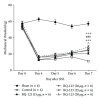Effects of repeated central administration of endothelin type A receptor antagonist on the development of neuropathic pain in rats
- PMID: 24073407
- PMCID: PMC3773389
- DOI: 10.1155/2013/529871
Effects of repeated central administration of endothelin type A receptor antagonist on the development of neuropathic pain in rats
Abstract
Endothelin-1 (ET-1) predominates in the endothelin family effectively in vascular tone control, mitogenesis, and neuromodulation. Its receptors are widespread in the central nervous system (CNS) associated with endogenous pain control, suggesting an important role of ET-1 in central pain processing. This study aimed to evaluate the effect of central ET-1 on the development of neuropathic pain behaviour by repeated intrathecal administration of endothelin type A receptor (ETAR) antagonist (BQ-123) in a sciatic nerve ligation (SNL) animal model. BQ-123 was administered intrathecally to rats at dosages 15 μg, 20 μg, 25 μg, and 30 μg, daily for 3 days. Mechanical allodynia was assessed daily 30 minutes before/after injection, 1 hour after injection of BQ-123 from post-SNL day 4 to day 6, and once on day 7 (without BQ-123 administration) before rats were sacrificed. Increasing trends of mechanical threshold were observed, and they reached significance at all dosages on post-SNL day 7 (P < 0.05 at dosage 15 μg and P < 0.001 at dosages 20 μg, 25 μg, and 30 μg) in comparison to control group. BQ-123 at dosage 30 μg showed the most stable and significant mechanical threshold rise. Repeated central administration of BQ-123 alleviated mechanical allodynia after SNL. Our results provide insight into the therapeutic strategies, including timing, against neuropathic pain development with ETAR antagonist.
Figures



Similar articles
-
Over-expression of astrocytic ET-1 attenuates neuropathic pain by inhibition of ERK1/2 and Akt(s) via activation of ETA receptor.Mol Cell Neurosci. 2014 May;60:26-35. doi: 10.1016/j.mcn.2014.02.007. Epub 2014 Mar 1. Mol Cell Neurosci. 2014. PMID: 24593954
-
Neuropathic pain induced by spinal cord injury: Role of endothelin ETA and ETB receptors.Neurosci Lett. 2016 Mar 23;617:14-21. doi: 10.1016/j.neulet.2016.02.005. Epub 2016 Feb 6. Neurosci Lett. 2016. PMID: 26861196
-
Contribution of peripheral endothelin ETA and ETB receptors in neuropathic pain induced by spinal nerve ligation in rats.Eur J Pain. 2010 Oct;14(9):911-7. doi: 10.1016/j.ejpain.2010.03.001. Epub 2010 Mar 28. Eur J Pain. 2010. PMID: 20350830
-
Intrathecal CGS-26303 Pretreatment Attenuates Spinal Nerve Ligation-Induced Neuropathic Pain in the Spinal Cord.World Neurosurg. 2016 Jul;91:532-541.e1. doi: 10.1016/j.wneu.2016.02.093. Epub 2016 Mar 4. World Neurosurg. 2016. PMID: 26947729
-
[Research progress on the role and mechanism of endothelin-1 in pain].Sheng Li Xue Bao. 2025 Feb 25;77(1):120-130. Sheng Li Xue Bao. 2025. PMID: 40065620 Review. Chinese.
Cited by
-
miRNA-23a/CXCR4 regulates neuropathic pain via directly targeting TXNIP/NLRP3 inflammasome axis.J Neuroinflammation. 2018 Jan 31;15(1):29. doi: 10.1186/s12974-018-1073-0. J Neuroinflammation. 2018. PMID: 29386025 Free PMC article.
-
Sub-anaesthetic dose of propofol attenuates mechanical allodynia in chronic post-ischaemic pain via regulation of PTEN/PI3K/IL-6 signalling.Mol Pain. 2023 Jan-Dec;19:17448069231185232. doi: 10.1177/17448069231185232. Mol Pain. 2023. PMID: 37314769 Free PMC article.
-
CXCR4/CX43 Regulate Diabetic Neuropathic Pain via Intercellular Interactions between Activated Neurons and Dysfunctional Astrocytes during Late Phase of Diabetes in Rats and the Effects of Antioxidant N-Acetyl-L-Cysteine.Oxid Med Cell Longev. 2022 Jun 28;2022:8547563. doi: 10.1155/2022/8547563. eCollection 2022. Oxid Med Cell Longev. 2022. PMID: 35799894 Free PMC article.
-
Mitochondrial DNA drives neuroinflammation through the cGAS-IFN signaling pathway in the spinal cord of neuropathic pain mice.Open Life Sci. 2024 May 31;19(1):20220872. doi: 10.1515/biol-2022-0872. eCollection 2024. Open Life Sci. 2024. PMID: 38840892 Free PMC article.
-
Endothelin receptor type A is involved in the development of oxaliplatin-induced mechanical allodynia and cold allodynia acting through spinal and peripheral mechanisms in rats.Mol Pain. 2021 Jan-Dec;17:17448069211058004. doi: 10.1177/17448069211058004. Mol Pain. 2021. PMID: 34894846 Free PMC article.
References
-
- Berti-Mattera LN, Gariepy CE, Burke RM, Hall AK. Reduced expression of endothelin B receptors and mechanical hyperalgesia in experimental chronic diabetes. Experimental Neurology. 2006;201(2):399–406. - PubMed
-
- Naidoo V, Naidoo S, Mahabeer R, Raidoo DM. Cellular distribution of the endothelin system in the human brain. Journal of Chemical Neuroanatomy. 2004;27(2):87–98. - PubMed
-
- Giaid A, Gibson SJ, Herrero MT, et al. Topographical localisation of endothelin mRNA and peptide immunoreactivity in neurones of the human brain. Histochemistry. 1991;95(3):303–314. - PubMed
-
- Kurokawa K, Yamada H, Ochi J. Topographical distribution of neurons containing endothelin type A receptor in the rat brain. The Journal of Comparative Neurology. 1997;389(2):348–360. - PubMed
Publication types
MeSH terms
Substances
LinkOut - more resources
Full Text Sources
Other Literature Sources
Miscellaneous

